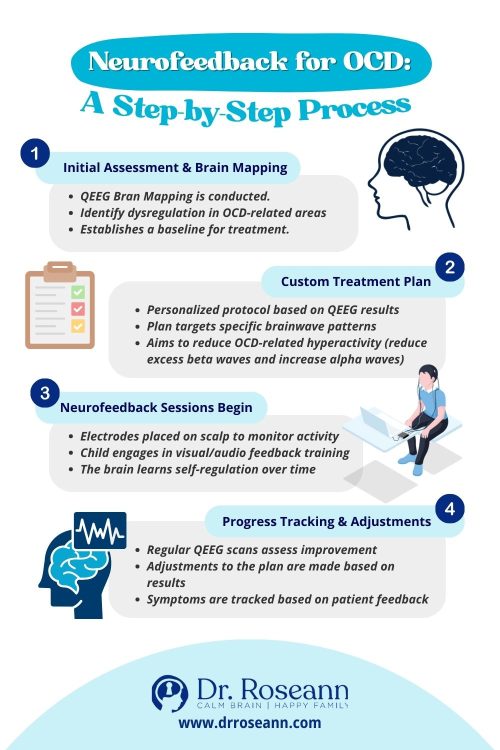Estimated reading time: 7 minutes
Watching your child struggle with intrusive thoughts, compulsions, repetitions, and overwhelming anxiety, is a routine no family should go through for a lifetime.
OCD can look different for every child, but one thing is certain: it disrupts their ability to feel in control, confident, and safe, and affects the lives of the people around them.
There are tons of therapies and medications that they say can help you treat your child’s OCD symptoms. But there’s nothing like treating it from the roots – and that’s exactly what neurofeedback for OCD is designed to do.
What is Neurofeedback and How Does it Help with OCD?
If your child can’t seem to shut off their thoughts or stop their rituals, it’s not stubbornness—it’s a dysregulated brain. Neurofeedback helps retrain the brain to respond in calmer, more flexible ways.
Using sensors that measure brainwave activity, neurofeedback gives the brain real-time feedback so it can learn to self-correct. Over time, this helps reduce OCD symptoms by strengthening the parts of the brain that manage focus, emotional control, and behavior.
Why it works for OCD:
- Helps break obsessive thought cycles
- Calms the “worry brain” without medication
- Supports emotional control and flexibility
- Builds healthier brain habits that last
Let’s calm the brain first—so your child can feel like themselves again.
How Does a QEEG Brain Map Guide OCD Treatment?
A Quantitative Electroencephalogram (QEEG) brain map is the first step in neurofeedback therapy. It provides a detailed analysis of brainwave activity, identifying areas of dysregulation associated with OCD.
Common findings in children with OCD:
- Prefrontal Cortex: Impaired decision-making and impulse control
- Anterior Cingulate Cortex (ACC): Heightened error detection and emotional distress
- Basal Ganglia: Dysfunctional habit formation and motor control
By pinpointing these areas, the QEEG guides the creation of a personalized neurofeedback protocol tailored to your child’s unique brain patterns.
What the Brain Map Tells Us:
- Overactive worry centers – OCD often lights up the cingulate gyrus and basal ganglia, areas tied to obsessive thoughts and emotional looping.
- Poor communication between brain regions – Brain maps often reveal dysregulation between the frontal lobe (decision-making) and limbic system (emotions).
- High beta waves – These fast brainwaves are often elevated in children with OCD, especially during rumination or compulsions.

What Does a Neurofeedback Session Look Like For a Child with OCD?
A typical neurofeedback session is calm, kid-friendly, and completely painless. Many children even look forward to it—especially those who love screens!
Here’s what to expect:
- Small sensors are gently placed on your child’s head to track brainwave activity
- Your child watches a movie or listens to music that responds to their brain in real-time
- When the brain makes healthy shifts, the screen plays smoothly—offering instant feedback
- Each session lasts about 30–60 minutes, usually 1–3 times a week

Can Neurofeedback Be Combined With Other OCD Treatments?
Absolutely. Neurofeedback complements other therapies, such as Cognitive Behavioral Therapy (CBT) and Exposure and Response Prevention (ERP), by enhancing brain regulation and emotional resilience.
Combined approach benefits:
- Accelerated progress in traditional therapies
- Reduced reliance on medication
- Holistic support for overall well-being
Is Neurofeedback Safe for Kids with OCD?
Yes, neurofeedback is a safe and well-tolerated therapy for children. It is non-invasive, does not involve medication, and has minimal to no side effects.
Safety highlights:
- No adverse effects reported in clinical studies
- Suitable for children and adolescents
- Monitored by trained professionals

Kayla’s Story: From Meltdowns to Breakthroughs with Neurofeedback
When Kayla’s mom first came to us, she was desperate. Her 11-year-old daughter had been struggling with severe OCD for over a year—washing her hands until they bled, refusing to touch doorknobs, and needing reassurance every few minutes.
Traditional therapy hadn’t worked. Medication only made Kayla feel “foggy and weird,” as she put it.
What Changed With Neurofeedback:
- A QEEG showed hyperactivity in Kayla’s cingulate gyrus and basal ganglia, which explained her obsessive loops and compulsions.
- After just a few weeks of neurofeedback, her sleep improved. The reassurance-seeking lessened. Meltdowns became rare.
- By month three, she was attending school regularly again—without crying spells or panic attacks.
“I feel like I can breathe again,” her mom told us, tearing up. “She’s laughing again. She’s my Kayla.”
Kayla’s brain had been stuck in a loop, and neurofeedback helped unstick it—gently and naturally.
It’s not bad parenting—it’s a dysregulated brain. And that can be rewired.
Parent Action Steps
FAQs
What age is appropriate for neurofeedback therapy?
Neurofeedback can be effective for children as young as 5 years old, depending on their ability to engage in the sessions.
How do I know if neurofeedback is working?
Progress is monitored through regular assessments and feedback from both the practitioner and your observations at home.
Is neurofeedback covered by insurance?
Coverage varies by provider and plan. It’s best to consult with your insurance company and the neurofeedback practitioner.
Can neurofeedback help with other conditions?
Yes, neurofeedback has been used to treat ADHD, anxiety, depression, and more.
How long do the effects of neurofeedback last?
Many individuals experience long-lasting benefits, especially when combined with supportive therapies and lifestyle changes.
Citations
Zaboski, B. A., Hampson, M., & Pittenger, C. (2023). Neurofeedback for obsessive compulsive disorder: A randomized controlled trial. Psychiatry Research, 327, 115278. https://doi.org/10.1016/j.psychres.2023.11527
Esmaeeli, S., & Moradi, A. (2021). The efficacy of neurofeedback training on obsessive-compulsive symptoms: A randomized controlled trial. Journal of Obsessive-Compulsive and Related Disorders, 30, 100653. https://doi.org/10.1016/j.jocrd.2021.100653
Khodabakhshi, M., & Alavi, K. (2022). The effectiveness of neurofeedback training on reducing obsessive-compulsive symptoms in children: A pilot study. Child Psychiatry & Human Development, 53(4), 678–685. https://doi.org/10.1007/s10578-021-01164-3
Dr. Roseann Capanna-Hodge is a licensed mental health expert that is frequently cited in the media:
- Single Care Controlling the uncontrollable: Living with OCD during a pandemic
- Holistic Counseling Podcast: Effective Treatments for OCD
- Epidemic Answers: Neurofeedback for ADHD, anxiety, OCD and mood
Disclaimer: This article is not intended to give health advice and it is recommended to consult with a physician before beginning any new wellness regime. *The effectiveness of diagnosis and treatment vary by patient and condition. Dr. Roseann Capanna-Hodge, LLC does not guarantee certain results.
Are you looking for SOLUTIONS for your struggling child or teen?
Dr. Roseann and her team are all about science-backed solutions, so you are in the right place!
Learn How Neurofeedback Therapy Safely Improves your Child’s Brain Function
©Roseann Capanna-Hodge








